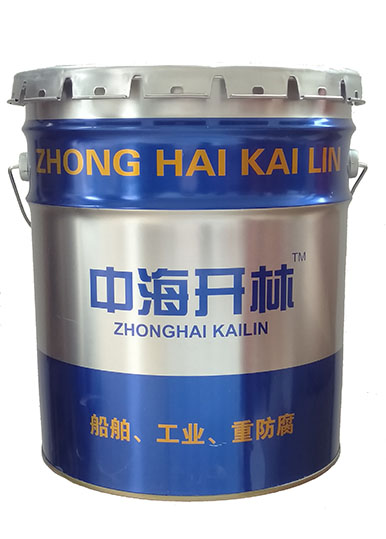



The composition consists of zinc powder, epoxy resin and polyamide curing agent, Auxiliaries and solvents, etc..
The main characteristics of the paint film contains a large amount of metal zinc powder, with cathodic protection; Excellent corrosion resistance and durability; Excellent adhesion and impact resistance; Excellent wear resistance; Excellent salt resistance to fog; Has a wide range of oil resistance and solvent resistance; Dry fast; Can be used with most of the high performance anti-rust paint and finish paint; Recognized by China Classification Society
Use for heavy corrosion proof system for steel structures such as large bridges, port machinery, heavy machinery, oil mining and mine equipment, buried pipeline, hydraulic steel Gates, steel structure, oil storage tank outer wall, gas cabinet outer wall, ship hull above waterline and deck as rust proof primer For use. It is the best primer for epoxy intermediate coating and epoxy finish.
Appearance gray no light
Construction parameters volume solid 56 % soil 3 %(as determined by CB/T9272 eqv IS 03233 :1988)(after mixing)
Matching group A: Already component = 91:9(weight ratio)
Dry film thickness 80 μm
Wet film thickness 143 μm
Theoretical dosage 314g/m2
Flash point A component(base) 27 °C, B component(curing agent) 35 °C
Dry time(25 °C) Table dry ≤ 2min, dry ≤ 24h, completely solidified 7D
Ripening time(mixed)(25 °C) 30 min
Available Time(after mixing A and B)
Temperature 5 °C 25 °C 30 °C
Available 24h8h6h
* When the temperature is greater than 30 °C, the application period of mixed component A and B is shortened with the increase of temperature.
Duplication interval
Temperature 10 °C 20 °C 30 °C
Minimum 48h24h16h
Up to several months(when zinc salt is not formed on the surface of the paint film)
Zinc-enriched primers have zinc salts(ie, broken zinc carbonate, also known as white rust) on the surface after being placed for a longer period of time. Therefore, they should not be exposed for a long time before coating the primer. For a longer coating interval, it is recommended to paint 842 epoxy rust resistant paint as a closed coating as soon as possible to reduce the amount of secondary rust removal work.
Zinc salt does not form on the surface of the paint film for several months in a clean indoor environment or within 14 days in a clean outdoor environment. However, in an industrial or maritime climate, zinc salts will soon be produced. Therefore, the interval between paint and paint should be as short as possible.
If zinc salt has been produced on the surface of the paint film of the H06-4 cyclooxygen-rich rust resistant paint and painted under the road primer, it should be treated by sweeping sand blasting or mechanical rust removal to remove all zinc salts and dirt.
It is suggested that the number of coating lanes should be 1 air spray, the thickness of dry film should be 50-80 U M, and 2-3 coating should be applied to brush or roll.
The rear track is equipped with paint 842 epoxy cloud iron rust proof paint, H53-31 iron-epoxy rust proof paint, H53-32 zinc oxide phosphate rust proof paint, H53-33 epoxy tripolyphosphate aluminum rust proof paint, 546 epoxy asphalt Super thick pulp rust proof paint, 846 epoxy asphalt thick pulp type Rust-proof paint, chlorinated rubber rust-proof paint or these types of paint.
However, it can not be used in conjunction with oily, alkyd, and polyester paints.
Surface treatment has skin oxide steel: sandblasting to Sa 2.5, surface roughness 30-75 μm or acid-washed treatment to remove all oxide skin, Rust, and complete neutralization, washing and passivation
Non-oxide leather steel: Sanding treatment to Sa2. Level 5, or polished to St 3 with wind or electric elastic wheel
.. Shop primer steel: paint film damage, rust and zinc base paint on the White rust
Secondary rust removal, white rust removed and polished to St 3
Under construction conditions, the substrate temperature must be higher than the dew point temperature of 3 °C; When the outdoor construction temperature is below 5 °C, the reaction between epoxy and curing agent stops and it is not appropriate to carry out construction. It is recommended to use H06-4 winter epoxy rich zinc anti-rust paint; Relative humidity not more than 85 %
Painting Method
Air Free Spray
diluent 103 diluent
Dilution 0-10 %(by paint weight)
The nozzle diameter is 0. 4-0 .5 M
Ejection pressure 15-17 MPa(about 150-170 kg/cm ')
Air spraying large area construction is not recommended, only for small area repair or small coated parts; diluent 101 diluent; Dilution 0-10 %(in paint weight); Nozzle diameter 2.0-3 .0 mm; Air pressure: 0.3-0 .4 MPa(about 3-4 kg/cm2)
Roll/brush thinner 103 thinner; Dilution 0-5 %(by paint weight)
Cleaning agent 103 diluent
Safety measures refer to the product safety technical specifications of Zhongsheng Paint(Ningbo) Co., Ltd..
Packaging component A(base) 20L barrel 32.5 kg
Part B(curing agent) 4 L barrel 3.2 kg
Note that the drying and curing time of epoxy zinc anti-rust paint is shortened with increasing temperature.
The cure time at different temperatures is as follows:
Temperature 10 °C 15 °C 25 °C 30 °C
Table dry 50 min 40 min 30 min 15 min
Complete cure & GT; 20d15d7d5d
The temperature can carry out the construction of H06-4 epoxy zinc rust resistant paint between 5-10 °C, but the curing speed is very slow;
When the temperature is below 5 °C, the reaction between epoxy resin and curing agent stops and it is not appropriate to carry out construction. In this case, the construction can be carried out in the painting workshop with a temperature above 5 °C, or the use of H06-4 winter epoxy zinc anti-rust paint
Adequate ventilation is required during construction and curing of H06-4 epoxy zinc rust resistant paint
Remark for the correct use of our products, please carefully read this manual "use guidelines."
Declare that the above information and data on this product are based on our experimental and practical experience and can be used as a construction guide. We are only responsible for the quality of the paint itself for the construction that we do not understand. We shall have the right to modify this instruction according to the continuous improvement of the product.
